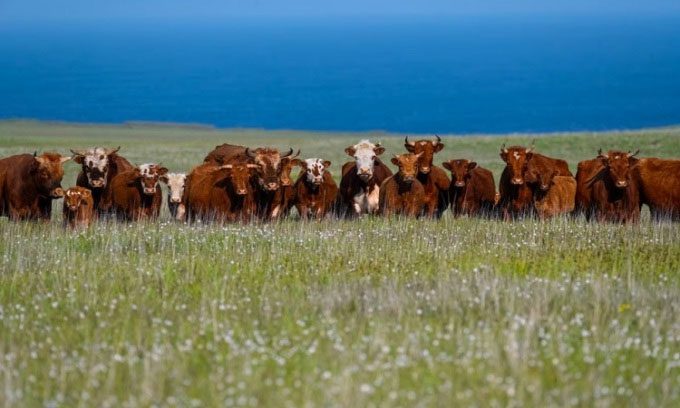Due to conditions on Chirikof Island, authorities have yet to find an effective way to manage the over 2,000 wild cows wandering here.
Located in the Gulf of Alaska, Chirikof is twice the size of Manhattan in New York. The island is situated 130 km southwest of Kodiak Island. Unlike Kodiak, which is home to the largest land predator, the brown bear, Chirikof is devoid of bears and humans; instead, the island is inhabited solely by wild cows, according to Popular Science.

Wild cows roam freely on Chirikof Island without predators. (Photo: Shanna Baker).
In an aerial survey conducted in 2015, authorities counted 2,024 cows living on Chirikof, part of a wildlife refuge in the United States. This number is more than double the initial estimated population of 800.
Russians brought livestock to Chirikof and other islands in the Kodiak archipelago to establish agricultural colonies. They left the herd behind when they sold Alaska to the United States in 1867. However, the pioneer of cattle ranching on the island was Jack McCord, a farmer and businessman from Iowa. He arrived in Kodiak in the 1920s and acquired the wild cows grazing on Chirikof. McCord introduced additional bulls to balance the herd and expand the gene pool, but he quickly lost control over them. By early 1939, he still had 1,500 wild cows—too many to manage. Storms and unpredictable weather made it difficult for most of McCord’s hired hunters to help reduce the herd. Ultimately, he gave up in 1950.
For years, the Alaska Maritime National Wildlife Refuge has planned to eliminate the non-native cattle that are damaging the habitats of seabirds and salmon. The refuge management is drafting proposals that include options such as leaving a portion of the herd on the island, culling some cows for meat, relocating them, or sterilizing them, and introducing natural predators like bears and wolves. The 11,736-hectare island can support about 500 cows under current land conditions, an estimate from a specialist at the Natural Resources Conservation Service suggests.
Over the years, several traders and ranchers have attempted to manage the cattle on Chirikof but have been unsuccessful. The challenges lie in transporting the cows from an island that lacks a natural port in an area with severe weather and unpredictable wind patterns.




















































